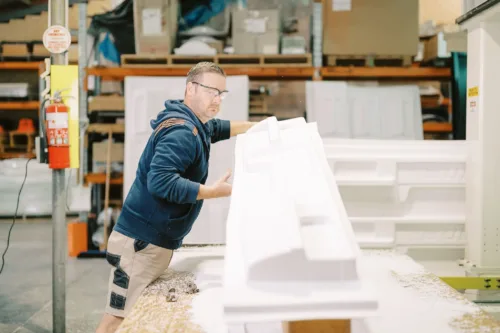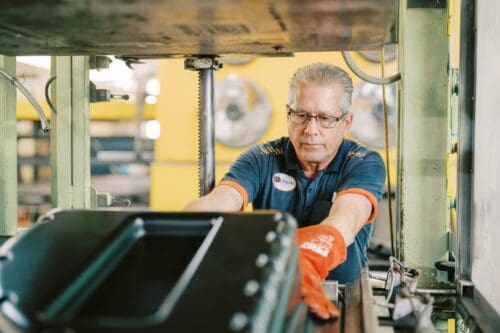

Vacuum forming has reimagined the potential of plastics, such as high-impact polystyrene sheeting (HIPS). The technique has been the catalyst for growth within the plastics industry and is now used to manufacture anything from recreational caravan parts to medical-grade hospital equipment.
So how does vacuum forming work? Read on for expert insight into vacuum forming and the role it plays in the modern plastics industry.
What is Vacuum Forming?
Vacuum forming is the technique used to transform flat sheets of plastic into three-dimensional shapes using thermal heating. This is done using a vacuum-forming machine. Let’s delve a little deeper into the relatively simple vacuum-forming process.
To use a vacuum forming machine, you must:
- Heat the plastic to a temperature where it becomes malleable. This can range between 100 and 225 degrees Celsius.
- When the optimum temperature has been reached, lay the plastic onto a mould, usually made of wood, machined aluminium or structural foam.
- Use the vacuum pressure to pull the plastic sheet tight against the mould.
- After being moulded, cool the plastic to set it in its new shape.
Female vs Male Moulds
Vacuum forming can be done using either female or male moulds. Female moulds see the thermoplastic sheet placed inside the mould and are used when outer dimensions are a priority. Male moulds see the sheet draped over the top of the mould and offer better precision when it comes to internal details and dimensions.
The Best Plastic for Vacuum Forming
People often ask which plastic is best for vacuum forming. Generally, vacuum forming requires thermoplastics, which are plastics that become flexible and pliable at certain temperatures, and then solidify when cooled. A common plastic used for vacuum forming is high-impact polystyrene sheeting (HIPS). Incredibly flexible, HIPS can be moulded into almost any shape.
Polycarbonate (PC) is another plastic used for vacuum forming. Amazingly tough, PC is resistant to flames, chemicals and water. This makes it a fantastic material for medical equipment and food manufacturing machinery.
Easy to mould, trim and fabricate, acrylonitrile styrene acrylate (ASA) is prime vacuum-forming material. It offers excellent weather resistance, making it ideal for use in outdoor applications, such as caravan and marine parts. High abrasion and chemical resistance also give ASA a competitive edge over other plastics.
Is Vacuum Forming Expensive or Cheap?
One of the major benefits of vacuum forming is its cost-effectiveness. While the machinery itself is an investment, it can be used to create a myriad of different products and is an extremely versatile workshop asset. Furthermore, once moulds are created, they can be used again and again to mass-produce a product or component. This makes vacuum forming one of the most cost-effective methods of plastic fabrication.
Incredible Plastic Products Made from Vacuum Forming
With so much flexibility, vacuum forming is used a lot within the plastics industry. But what is vacuum forming used to make, exactly? Here are some of our favourite products from vacuum forming.
Gold detector covers
Vacuum forming offers manufacturers incredible flexibility, which is why it’s often used to create intricate products and components. This gold detector cover is just one example of how vacuum forming is used to create custom solutions.
Caravan components
From compact bathrooms and custom doors to taillight panels and spare wheel covers, vacuum forming is extremely useful in the caravan industry. Components are often made with ASA, a tough and durable material that can easily withstand scratches, dents and other imperfections that come with caravanning adventures.
Chocolate moulds
Everyone loves chocolate and in many cases, vacuum forming is to thank for the delicious treats. From candy bars to gourmet truffles, vacuum forming is often used to shape thin-film PETG/VYVAC into chocolate moulds.
Baby bassinet
Vacuum forming is invaluable when clean, ultra-smooth edges are critical. This baby bassinet was made using a clear polycarbonate (PC) material vacuum formed over a mould then cooled overnight.
Limestone pavers
Love the intricate patterns of limestone pavers used in pool areas and driveways? This effect is often created using patterned trays made from ABS.
Are you looking for expert plastic fabrication in Perth? BCJ Plastic Products has more than 40 years’ experience in vacuum forming. Get a quote online or call us on (08) 9353 3477 to find out more about the vacuum forming services available at BCJ Plastic Products.


Innovative Plastic Manufacturing: Vacuum Forming and Prototyping for Unique Projects
Read article

